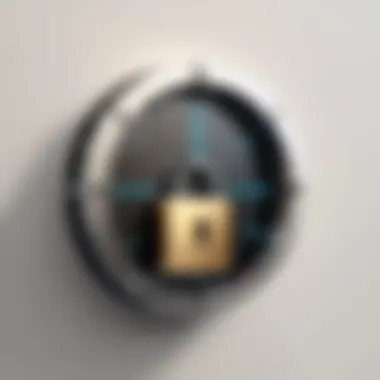Crafting Strong Passwords: Your Essential Guide


Intro
In today's digital landscape, where our personal and professional lives are interwoven with technology, password security has never been more critical. It's alarming how many individuals tend to use “123456” or “password” as their go-to keys to the digital world. Effectively crafting robust passwords is not just a technical necessity; it's a shield against the increasing tide of cyber threats. This guide is intended to illuminate the noble art of password creation and management, blending both foundational concepts and cutting-edge techniques.
Password crafting goes far beyond mere memorization of more complex strings. One must understand the frameworks through which passwords serve their purpose. Unique passwords can be your first line of defense against unauthorized access, ensuring that your sensitive information remains safeguarded. This document systematically breaks down the components of password construction, while also addressing the importance of tools such as password managers that can simplify the often-overwhelming task of keeping track of various credentials.
To frame our discussion, we will dive into the crucial aspects that define effective passwords, highlight common mistakes, and propose actionable strategies for enhancing overall password security. Our target audience—IT professionals and technology enthusiasts alike—will benefit from not just a surface-level understanding, but a detailed blueprint that fosters a more secure digital environment.
"Cybersecurity is much more than a matter of IT. It's a matter of risk management."
— Unknown
With that said, let’s move into the practical details, starting with a hardware overview. The devices we utilize daily play a significant role in how we secure our data and access levels. Awareness and understanding of this is the first step towards better password protection.
Understanding the Importance of Password Security
In today’s interconnected world, where everything from banking to social networking happens online, the importance of password security cannot be overstated. Passwords act as gates—essential barriers that prevent unauthorized access to your personal and sensitive information. The convenience of digital services often tempts individuals to overlook the necessity of robust passwords, leading to potentially grievous consequences.
A strong password is not just a requirement; it’s a frontline defense against cyber threats. This article aims to shed light on various aspects of password security, detailing not only how to create effective passwords but also why doing so is crucial in this digital landscape.
The Role of Passwords in Digital Security
Passwords serve as the primary means of authentication in digital environments. They validate your identity, allowing systems to distinguish between legitimate users and potential intruders. A simple analogy can illustrate this: think of a password as the unique key to your home. Would you leave your door unlocked? Likely not. The same principle applies to online accounts. Each account you own—be it for email, social media, or financial services—requires a unique password to safeguard it.
With the increasing sophistication of cyber attacks and the prevalence of data breaches, relying on weak or default passwords is tantamount to inviting trouble. A strong password can thwart many attacks, including brute force attempts and phishing scams.
Consequences of Weak Passwords
The ramifications of weak passwords stretch far beyond inconveniences. Here are some consequences to consider:
- Unauthorized Access: Weak passwords make it easy for hackers to gain access to personal data, which could include details like your name, home address, or financial information.
- Identity Theft: Once a hacker infiltrates an account, they can impersonate you, leading to financial loss, damaged credit, or even legal troubles.
- Compromised Sensitive Information: Weak passwords may expose sensitive company data in corporate environments, potentially damaging reputation and trustworthiness.
"One weak link in your password chain can unravel the entire tapestry of your digital life."
As the statistics indicate, many people tend to reuse passwords across multiple accounts, which exacerbates the risks. If one account is compromised, it becomes a game of dominoes, affecting all linked accounts. Taking the time to create strong, complex passwords is not just a hassle; it’s a crucial step in protecting your digital presence.
In summary, understanding the significance of password security is imperative for anyone navigating the vast digital landscape. Recognizing the role that passwords play and the severe consequences of lax password practices sets the stage for developing robust password strategies, which will be explored in the subsequent sections of this article.
Characteristics of a Strong Password
Crafting a strong password is akin to building a solid fortress around your digital self. Just as a castle requires thoughtful planning and resilient materials, your password needs certain characteristics to effectively shield your accounts from unwelcome intrusions. The significance of a robust password cannot be overstated; it is often the first line of defense against unauthorized access. Let’s explore the elements that form a security-enhancing password—length, complexity, and unpredictability.
Length: Why It Matters
When it comes to passwords, length truly plays a crucial role. It’s simple math: the longer the password, the greater the number of potential combinations an attacker needs to guess or crack it. An eight-character password may seem decent, but with today’s powerful computing capabilities, it can be breached in a matter of minutes or even seconds. Ideally, a strong password should have at least 12 to 16 characters.
Imagine each character adds a layer, like stacking bricks in the wall. Each additional character increases the time an attacker would spend trying to breach it exponentially.
- A longer password:
- Increases Security: More characters mean more possibilities.
- Offers Flexibility: You can still use memorable phrases without compromising security.
While it might be tempting to stick to short and sweet passwords, this choice ultimately compromises safety. For those who worry about the burdensome task of remembering lengthy passwords, using phrases or combining unrelated words can transform a lengthy string into something memorable yet secure.
Complexity: Mixing Characters


Complexity is the next building block in the construction of a strong password. This does not just mean tossing in a smattering of numbers or symbols. To enhance strength, a wise strategy involves mixing uppercase letters, lowercase letters, numbers, and special characters.
A password like "Password123" is all too common and easy to crack. Instead, consider a passphrase such as "C0mplicated_Ar%27s!tech*2024," which offers complexity without sacrificing memorability.
- Benefits of complexity include:
- Resistance to Attacks: Attackers often use dictionaries of common phrases and patterns. A complex mix dismantles these attempts.
- References the Cognitive Load: Complex passwords are harder to memorize but less predictable, making them impervious to simple hacking attempts.
Adopting a complex password is like fortifying that wall with an intricate design; it makes it harder for intruders to find a way in.
Unpredictability: Avoiding Common Patterns
Predictability is the Achilles' heel of password security. Many users fall into comforting patterns—like using their birth dates, pet names, or keyboard sequences. Such choices can lead to disaster. It’s critical to forge passwords that lack recognizable patterns.
To illustrate, let’s look at some common patterns to avoid:
- Sequential Characters: "123456" or "abcdef"
- Personal Information: Dates of birth, anniversaries, or usernames
- Common Words: Names of family or favorite places.
Instead, aim for randomness. Consider using a combination of unrelated words such as "Pineapple_Sneaker19$Blue".
A password that seems like a random collection is much harder for an attacker to crack than something that follows a typical structure.
Creating an unpredictable password resembles a maze—where the twists and turns keep potential intruders guessing and hinder their progress.
In summary, when you construct passwords anchored in strong characteristics of length, complexity, and unpredictability, you thoroughly enhance your digital defenses. Strengthening your approach can significantly mitigate risks in a world where cyber threats loom large.
Employing these principles can transform you from a target into a fortress.
Best Practices for Password Creation
In the digital age where cyber threats lurk around every corner, best practices for password creation serve as the frontline defense against unauthorized access. Crafting effective passwords is not merely a task; it is an essential skill for safeguarding sensitive information. This section dives into fundamental strategies that elevate password security, offering both technical insights and practical advice.
Using Passphrases Strategically
Passphrases are gradually gaining recognition as an effective alternative to traditional passwords. A passphrase typically involves combining several words to create a string that is both lengthy and memorable. For instance, instead of using the password "T0d@Y!", consider a phrase like "WalkingOnTheMoonSince1969!". Not only does this approach bolster length, but it also weaves in elements of unpredictability.
When creating passphrases, it’s crucial to choose unrelated words or concepts. Avoid common phrases that might be easily guessed. Instead, mix nouns, verbs, and numbers that resonate personally with you yet remain obscure to others. Such an approach not only enhances security but also takes the hassle out of memorizing complex strings.
Utilizing Random Password Generators
Using a random password generator can be a game-changer. These tools create unique, complex passwords that are virtually impossible to crack. They typically generate passwords containing a mixture of uppercase letters, lowercase letters, numbers, and special symbols. By working with a password generator, a user avoids human tendencies such as repeating patterns or incorporating easily accessible personal information.
"The less predictable your password is, the more secure it will be."
These generators can be found both online and as features within password managers, making them easily accessible. For example, services like LastPass or 1Password include built-in generators that create secure passwords with just a few clicks. Utilizing these tools not only elevates security but also simplifies the maintenance of numerous accounts.
Implementing Two-Factor Authentication
Two-factor authentication (2FA) adds another layer of security that has become essential in modern digital practices. With 2FA, a user must provide two different types of information before accessing their account—typically something they know (like a password) and something they have (like a mobile device). This could mean entering a one-time code sent via text or using an authentication app.
The beauty of 2FA lies in its ability to mitigate the risk of compromised passwords. Even if a password is stolen, the intruder would still need the second factor to gain access. Make it a point to enable 2FA wherever possible. Many services and platforms now incorporate this feature, recognizing its necessity in safeguarding personal and professional data.
In summation, implementing best practices for password creation serves not just as a guideline but as a crucial methodology in today’s ever-evolving cyber landscape. Developing secure passwords, strategically using passphrases, leveraging random generators, and incorporating two-factor authentication are steps that cannot be overstated in their importance to anyone concerned about their digital security.


The Necessity of Unique Passwords
In the rapidly evolving digital landscape, the necessity of unique passwords cannot be overstated. Each online account—be it for banking, social media, or shopping—has its own set of vulnerabilities, and having a unique password for each one helps minimize risks significantly. Essentially, unique passwords act as individual locks to your personal information, reducing the chances of an entire system compromise following a breach of one account.
Risks of Reusing Passwords
Reusing the same password across multiple platforms opens a can of worms. If one site suffers a data breach, hackers can easily apply that same password to your accounts on different sites. It's like giving a burglar the keys to your home just because they got a hold of your car keys. The implications can be severe—a single leaked password can cascade into identity theft, unauthorized transactions, or social media impersonation.
Furthermore, many people overlook how often their data is at risk. Studies reveal that sites are breached more frequently than we assume. The Equifax incident in 2017, affecting over 147 million people, is a stark reminder of how even large companies can fall victim. Relying on a single password may save you a bit of effort in the short-term, but it will likely cost you dearly down the line.
Some risks associated with reusing passwords include:
- Account Takeover: One compromise can lead to multiple accounts being hacked.
- Data Exposure: Personal information stored across sites can be accessed.
- Reputational Damage: If sensitive accounts are hacked, it can tarnish your online credibility.
Creating Unique Passwords for Each Account
Crafting unique passwords for each account doesn't have to be a Herculean task. One effective method is to use memorable phrases or sentences, modified with special characters and numbers. For instance, take the phrase "I love my dog Max!" and transform it into something like "ILuvMyD0gM@x!123". This way, you create a memorable password that remains unique.
You can also implement password managers to take the headache out of tracking your passwords, storing them in one secure vault while still maintaining unique entries for each platform.
"The more unique passwords you have, the tougher it is for someone to get into your accounts."
Consider using a combination of alphanumeric and symbols to create randomized passwords. Here’s a simple formula:
- Use the first letter of each word in a sentence.
- Switch letters with numbers (e.g., A=4, E=3).
- End with a special character that’s meaningful to you, then toss in a number.
An example would be taking "The sun sets in the West at 6 PM" and turning it into "TssitW@6PM!".
Ultimately, being conscientious about password uniqueness not only protects you, but fosters a broader culture of security that benefits the digital community as a whole. The more we prioritize unique passwords, the more we contribute to a safer online environment.
Password Management Techniques
Password management techniques play a crucial role in maintaining the integrity of one's digital security. As cyber threats evolve, the necessity of robust password practices cannot be overstated. These techniques not only simplify the process of managing numerous credentials across various platforms but also enhance security against potential breaches.
Using effective password management techniques can significantly reduce human error while dealing with passwords. People often fall into the trap of reusing passwords or opting for simple combinations due to the difficulty of remembering complex ones. However, with the right techniques, it's possible to balance security and convenience efficiently.
Benefits of Using Password Managers
Password managers serve as a fortified vault for all your passwords and personal information. Here are some key benefits of utilizing a password manager:
- Secure Storage: They encrypt your passwords, ensuring that even if the data is compromised, it remains unreadable without the master password.
- Auto-fill Capabilities: Many password managers can automatically fill in passwords for you, saving time and reducing the hassle of manual entry.
- Password Generation: These tools often include random password generators, creating strong, unique passwords for every account, thus significantly reducing vulnerability.
- Accessibility Across Devices: Most password managers offer cloud-based solutions that allow you to access your passwords from various devices securely.
- Monitoring for Breaches: Some password managers also provide breach monitoring services, alerting you if any of your saved passwords are part of known data leaks.
Utilizing a password manager translates into a seamless, efficient password strategy that not only secures accounts but also promotes good habits.
Choosing the Right Password Manager
Selecting an appropriate password manager requires careful consideration of several factors:
- Security Features: Look for strong encryption methods, additional multi-factor authentication, and privacy policies that ensure your data is not sold or shared.
- Platform Availability: Ensure the password manager is compatible with all your devices and offers browser extensions for various browsers.
- User Interface: The tool should be easy to navigate. An intuitive user interface helps in maintaining good password practices over time.
- Backup and Recovery Options: Check if the password manager offers reliable backup options and straightforward recovery processes in case you forget your master password.
- Pricing Structure: Some password managers offer solid free versions, while others may require a subscription. Evaluate whether the pricing aligns with the features you need.
Common Password Pitfalls to Avoid
In the realm of cybersecurity, understanding the common pitfalls related to password management is crucial. Awareness of these pitfalls can save individuals and organizations from catastrophic breaches and data losses. This section concentrates on the most frequent mistakes people make while creating and managing passwords. By recognizing and avoiding these missteps, one can fortify their digital defenses effectively.


Using Personal Information
One mistake that many folks tend to make is using personal information in their passwords. Think about it: birthdates, names of pets, or even addresses can be easily guessed or obtained by cyber criminals. In an age where social media is prevalent, attackers can scour platforms like Facebook or LinkedIn for information. The more they know about you, the easier it is to crack your passwords.
- Examples of personal details to avoid:
- Instead, consider using unrelated words or phrases that only hold significance to you.
- Birthdates or anniversaries
- Names of family members or pets
- Phone numbers
Ultimately, a password should be a fortress built from obscure bricks—ones that are individually insignificant, yet collectively create a robust barrier.
Neglecting Regular Updates
Another common trap is neglecting to update passwords on a routine basis. Imagine this: you set a strong password once, and then you forget about it while continuing to use it for years. This complacency can lead to disaster if a password is compromised. Regular password updates serve as a preventive measure to mitigate risks.
"An ounce of prevention is worth a pound of cure."
- A few guidelines for effective password updates include:
- Change passwords every 3 to 6 months.
- Implement reminders in your calendar or notes application.
Many facilities and organizations enforce strict policies around password updates for a reason—they understand that a proactive approach is often more effective than a reactive one.
Ignoring Breach Notifications
Lastly, ignoring breach notifications is akin to leaving the front door unlocked while traveling. Many tech companies and even government agencies notify users of security breaches, and turning a blind eye to these alerts can be detrimental.
When you receive such a notification, you should:
- Promptly change your password for the affected account.
- Monitor your account activity for any unusual behavior.
- Consider using banking alerts for any financial accounts linked to the compromised service.
Ignoring these notifications may lead to unauthorized access and potentially devastating consequences for personal or organizational security. Be present and react promptly; your digital safety may depend on it.
In summary, it’s vital to be vigilant about common password pitfalls. By steering clear of these traps, you can take significant strides in enhancing your digital security.
The Future of Password Security
As technology marches forward at a dizzying pace, the landscape of digital security is experiencing seismic shifts. Passwords have long stood as the first line of defense against cyber threats. However, as hackers grow more sophisticated and data breaches become alarmingly frequent, the traditional notions of password security are fast becoming outdated. This brings us to the crux of our discussion: the future of password security and its implications for safeguarding sensitive information. Understanding these trends is more than just an academic exercise; it's essential for anyone who navigates the digital realm.
Emerging Technologies and Trends
In the realm of password security, it's becoming clear that simply relying on alphanumeric combinations won't cut it in the years to come. Emerging technologies are paving the way for innovative solutions. One of the most talked-about advancements lies in artificial intelligence and machine learning. These technologies can analyze vast datasets to detect patterns, helping to identify compromised accounts much quicker than any human could.
But there are also other considerations worth noting:
- Decentralized Identity Systems: These systems aim to put control back into users' hands by eliminating password reliance altogether. Users can authenticate through cryptographic methods that don't require centralized databases, reducing single points of failure.
- Passwordless Authentication: Solutions like single sign-on and token-based access are making headway. These enable access without needing traditional passwords, often using verification codes sent to a user’s mobile devices instead.
- Security Fobs and Wearables: As the Internet of Things continues to grow, integrating physical devices into authentication processes seems a natural progression. Devices like smartwatches can serve as security keys.
The password of the future may not even be a password at all, but an amalgamation of identity verifications that leverage multiple technologies.
The Role of Biometrics in Passwords
Biometric authentication is emerging as a powerful alternative to conventional passwords. We’re not just talking about fingerprints or facial recognition; the future may hold even more advanced methods.
Consider the following benefits of incorporating biometric solutions into password security:
- Enhanced Security: Biological traits are unique to individuals. Thus, using these for authentication makes it incredibly difficult for unauthorized users to gain access.
- User Convenience: Say goodbye to the burden of remembering complex passwords. With fingerprints or facial recognition, the user experience becomes seamless.
- Adaptability: As biometric technologies develop, various forms of identification can be integrated, such as voice recognition or even iris scanning.
Nonetheless, there remain some concerns that nestle beneath the surface. Privacy issues, data storage, and the potential for biometric theft raise alarms that cannot be ignored. These technological shifts must be accompanied by careful consideration to safeguard users’ rights.
As we look ahead, the future of password security will be characterized by these emerging solutions and trends. Adopting robust, multifaceted strategies will be essential for IT professionals and tech enthusiasts to secure their digital realms effectively.



